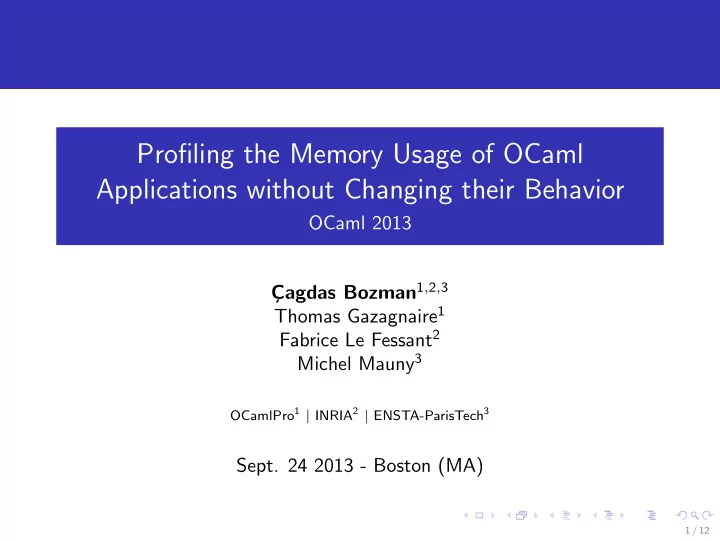

Profiling the Memory Usage of OCaml Applications without Changing their Behavior OCaml 2013 ¸agdas Bozman 1 , 2 , 3 C Thomas Gazagnaire 1 Fabrice Le Fessant 2 Michel Mauny 3 OCamlPro 1 | INRIA 2 | ENSTA-ParisTech 3 Sept. 24 2013 - Boston (MA) 1 / 12
Memory Problems What ? Study the memory behavior of OCaml programs Memory profiling tools Why ? To decrease memory footprint To fix memory leaks To spend less time in memory management 2 / 12
Real World Example – Why3 1 (1/2) 1 Why3 is a platform for deductive program verification (http://why3.lri.fr/) 3 / 12
Real World Example – Why3 (2/2) With locations precision 4 / 12
How do we do that ? $ opam switch 4.00.1+ocp-memprof $ opam install why3 $ OCAMLRUNPARAM=m why3replayer.opt -C why3.conf p9 16 this step will generate a lot of snapshots of heap image No need to change your code nor the compilation options. No impact on execution time. $ opam install ocp-memprof $ ocp-memprof -loc -sizes PID this step analyzes all these snapshots Look at the graphs. 5 / 12
Snapshots What is a snapshot ? Compressed version of the heap Location identifiers, graph with pointers, etc. Save globals (toplevel modules) How do we obtain these snapshots ? Computed by a linear scan of all chunks 2 which contain sets of consecutive blocks. 2 huge block of memory 6 / 12
Generate A Snapshot Two ways to trigger the generation of snapshots Use OCAMLRUNPARAM=m force a program to generate a snapshot after every GC Request explicitly the program to generate a snapshot by sending a HUP signal (very useful for server-like application, cf mldonkey) in module GC , use the following function val dump heap : string -> unit 7 / 12
Patched Compiler (1/3) OCaml memory block: 8 / 12
Patched Compiler (1/3) OCaml memory block: OCaml block’s header (one word) on 64-bit machines: 8 / 12
Patched Compiler (2/3) Header after our modification: 9 / 12
Patched Compiler (3/3) � Minimal impact on performance (only when generating snapshots) 10 / 12
Patched Compiler (3/3) � Minimal impact on performance (only when generating snapshots) No space overhead 10 / 12
Patched Compiler (3/3) � Minimal impact on performance (only when generating snapshots) No space overhead No impact on GC (its behavior is not changed) 10 / 12
Patched Compiler (3/3) � Minimal impact on performance (only when generating snapshots) No space overhead No impact on GC (its behavior is not changed) ⊖ Only on 64-bit platforms 10 / 12
Patched Compiler (3/3) � Minimal impact on performance (only when generating snapshots) No space overhead No impact on GC (its behavior is not changed) ⊖ Only on 64-bit platforms Location identifiers are limited (2 21 ∼ 2 million allocation sites) 10 / 12
Patched Compiler (3/3) � Minimal impact on performance (only when generating snapshots) No space overhead No impact on GC (its behavior is not changed) ⊖ Only on 64-bit platforms Location identifiers are limited (2 21 ∼ 2 million allocation sites) Maximum block size is now 64GB 10 / 12
One Tool Based On Identifiers ∗ A cmt file is a binary file containing the typed AST 11 / 12
Conclusion Future Work: Improve the current framework Aggregate information by type and location (work in progress) Recover more types (e.g. using G.Henry’s work) Display life span of values (number of GC for example) More tools based to analyzed snapshots: a graphical assistant to explore snapshots a tool which use pointers to see which root retains some specific values Questions ? 12 / 12
Recommend
More recommend